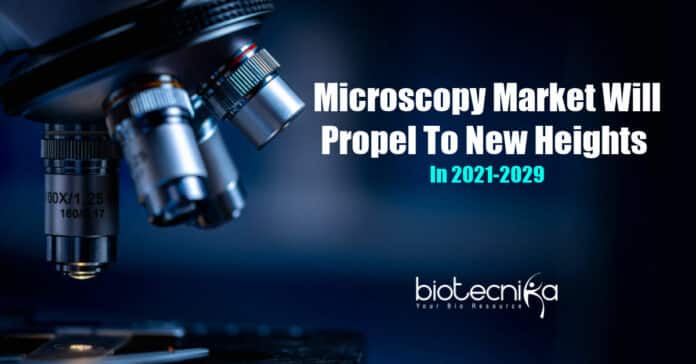Worldwide Microscopy Devices Industry Expected to Grow 10% in 2021-2029
The global market for life science microscopy devices is foreseen to expand at a CAGR of 10% between 2021 and 2029. With exceptional innovation and technological expertise for the visualization, measurement, and interpretation of microstructures, the life science area supports the scientific community’s imaging needs. It represents an indispensable function in the health care sector, research sector, and laboratory testing.
Under a microscope, images can also be magnified by many other waveforms like acoustic, X-ray, or electron beam and be received by direct or digital imaging or by a blend of these techniques. The main applications of life science microscopy include testing laboratories, pharmacies, and biotechnology firms. The most common users of life science microscopy devices are testing laboratories.
Key Growth because of Focus on research and development
The major driving factor in the life science microscopy devices market is the rising R&D expense for the development of better and more advanced products. The growing inclination to use microscopy in life science R&D is contributing to the expansion of the life science microscopy devices market. The increasing pervasiveness of chronic diseases and the incidence of acute infections around the globe
are driving up demand for microscopy, supporting the profitable growth of the life science microscopy market. But, the price of the microscope is one of the limiting factors in the area of budget constraints in the life sciences.Use of microscopy devices in drug discovery is a driving factor
Due to the increased research activity, the microbiology and cell biology segments account for the largest share in the life science microscopy devices market. The growing healthcare expenditure encourages research, which propels the microscopy market to new heights. One of the primary revenue generators of life science microscopy devices is progress in pharmacology, particularly drug discoveries in terms of more extensive treatment aspects of globally widespread diseases.
Microscopy is also crucial in ADMET testing in toxicology; it aids in the conservation of resources wasted on drug discovery because many drugs fail during the metabolism or absorption phases. In the life science microscopy devices market, the toxicology and pharmacology segments are expected to grow significantly. Effective disease study is critical for treatment, making microscopes more desirable in the pathology field.
Cryo-Electron Microscopy Gaining Traction
Cryo-electron microscopy has grown to be a crucial tool for determining the 3D structure of macromolecule complexes at subnanometer resolution. It has also been used to observe helical and 2D crystalline specimens. These microscopes have also been utilized to obtain a near-atomic resolution, which has aided in the atomic-level research of biological functions of various molecules. Microscopy has also been able to achieve greater accuracy by combining a number of methods like X-ray crystallography, which has been utilized as a phasing model to resolve crystallographic structures of different macromolecules.
Peak demand for microscopes during the pandemic
Electron microscopy techniques have undoubtedly been useful in recent COVID-19 R&D. From identifying vaccine candidates to solving the SARS-CoV-2 spike protein, research laboratories globally have been collaborating with electron microscopists to study cells, viruses, and proteins at the molecular level. This resulted in a swift increase in sales and, as a result, the growth rate of the microscopy devices market.
North America will be dominant
Because of the adaptability of advanced technology in the healthcare and life science fields, North America is expected to dominate the market for life science microscopy devices, followed by Europe. Advanced R&D infrastructure, as well as enhanced funding for life science research and drug discovery in North America, all, add significantly to the market’s fruitful growth. Because of the presence of significant manufacturers of life science microscopy devices, North America and Europe hold the majority of the market share. The Asia-Pacific region will experience significant growth in the coming years as a result of expanding research plants, growing health awareness, and government-led initiatives.
Key Players
Pivotal players in this market involve Bruker, Carl Zeiss AG, Carl Zeiss Microscopy GmbH, Hitachi High-Technologies Corporation, JEOL Ltd, Leica Microsystems, Keyence Corporation, Nikon Corporation, Olympus Corporation, PicoQuant, Thermo Fisher Scientific Inc.
Also Read:
- PhD Mandatory From 2023 For Assistant Professors: UGC
- Comprehensive Atlas Of Brain Cells – A Neuroscience Dream
- Can We Predict Next Virus Spread From Animals to Humans With AI?
- World’s First Malarial Vaccine To Be Produced By Bharat Biotech
Download Biotecnika App for more Updates on Life Sciences, Job vacancies, CSIR-NET, GATE, and a lot more.
Keywords: Worldwide Microscopy Devices Industry Expected to Grow 10%






























